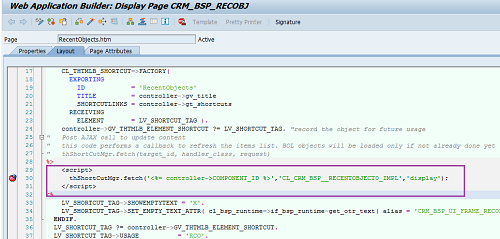
- SAP Community
- Products and Technology
- CRM and Customer Experience
- CRM and CX Blogs by SAP
- What is uif_callback doing
CRM and CX Blogs by SAP
Stay up-to-date on the latest developments and product news about intelligent customer experience and CRM technologies through blog posts from SAP experts.
Turn on suggestions
Auto-suggest helps you quickly narrow down your search results by suggesting possible matches as you type.
Showing results for
Employee
Options
- Subscribe to RSS Feed
- Mark as New
- Mark as Read
- Bookmark
- Subscribe
- Printer Friendly Page
- Report Inappropriate Content
12-02-2015
7:59 AM
UIF_CALLBACK is a service, as seen from its description in SICF – ‘Generic callback’, it is used to dispatch the requests into specific classes which are specified as value of parameter ‘crm_handler'. It’s handler class is: CL_CRM_WEB_UTILITY:

In this article, I will explain with some samples how this service runs.
Sample 1:
We all know, for performance purpose, when CRM webui is loaded, Java script files under BSP Application THTMLB_SCRIPTS will be merged into one scripts.js file:

But in this way, it is not convenient to debug when we have some java script problems. Thus user parameter BSP_DLC_DEBUG_PARAM is introduced(in SAP Note 1771865). When this user parameter is set to JS_ALL_FRAMES, things will be changed -- all java script files under BSP Application THTMLB_SCRIPTS will not be merged and loaded into one file, they will be loaded separately and one by one.


From the trace, we can see the service uif_callback is being used, for example:
…/SAP(====)/webcuif/uif_callback/crm_ui_frame/SCRIPTS_.GLOBALS.JS?CRM_HANDLER=CL_THTMLB_SCRIPTS_MANAGER…
Here, value for parameter CRM_HANDLER is CL_THTMLB_SCRIPTS_MANAGER.
How is it done?
In method CL_THTMLB_CONTENT-> IF_BSP_ELEMENT~DO_AT_BEGINNING, parameter BSP_DLC_DEBUG_PARAM is checked. If it is not set, the JS script will be ‘thtmlb_scripts/scripts.js’. But if it is set to value JS_ALL_FRAMES, requests of ‘…webcuif/uif_callback/…’ will be formed instead:

Then how are these classes working?
Let’s set a breakpoint in methods CL_CRM_WEB_UTILITY-> IF_HTTP_EXTENSION~HANDLE_REQUEST and CL_THTMLB_SCRIPTS_MANAGER-> IF_CRM_WEB_CALLBACK~HANDLE_REQUEST and see what happens.
- When the request is sent to backend system, CL_CRM_WEB_UTILITY-> IF_HTTP_EXTENSION~HANDLE_REQUEST parses the request parameters and gets the handler class, here it is CL_THTMLB_SCRIPTS_MANAGER:

- Object is created and initialized:

- Application handler is called back:

- Inside the method CL_THTMLB_SCRIPTS_MANAGER->IF_CRM_WEB_CALLBACK~HANDLE_REQUEST, requests are processed, the .JS content is read and returned:

- From the httpwatch trace, we can see the JS content is returned:

Sample 2:
As introduced in SAP Note 2181937 ( Recent Items Filtering ), ‘Recent Items’ have filter functions added. Now, for the initial load of recent Items, for the filter dropdown list, for the items retrieving on a specific filter, they are using UIF_CALLBACK.
Take initial load of recent items as an example:
- In crm_bsp_recobj/RecentObjects.htm, there are codes:

- 'Fetch' function is defined in THTMLB_SCRIPTS-> scripts_areaframe.js.

- In this function, the request is sent out:

value for parameter ajaxURL is: "/sap(bD1FTiZjPTUwNCZpPTEmZT1TVEF6TXpVME1WOWZYMTlmTkRkZk1Ua3dBRkJXckViRUh1V21sQlNIX1ZJM2JnJTNkJTNk)/webcuif/uif_callback?crm_handler=CL_CRM_BSP__RECENTOBJECT0_IMPL&crm_controller=C6_W23_V24&wcf_request=display&wcf-request-ticket=CDB907FAF99F328F1997F34FF2C21322" - The same, if we set breakpoint in CL_CRM_BSP__RECENTOBJECT0_IMPL-> IF_CRM_WEB_CALLBACK~HANDLE_REQUEST, we will get the callstack:

The same thing happens when click the triangle icon for ddlb and select an item to filter:


Additional:
There are many other usages via this service uif_callback. For example, CL_THTMLB_COLOR_UTIL, CL_CRM_UI_SESSION_MANAGER, CL_THTMLB_COLOR_UTIL, CL_THTMLB_SMART_VALUE_HELP, CL_THTMLBX_SILVERLIGHT_ISLAND, CL_THTMLBX_FLASH_ISLAND, etc.
- SAP Managed Tags:
- CRM WebClient UI
2 Comments
You must be a registered user to add a comment. If you've already registered, sign in. Otherwise, register and sign in.
Labels in this area
-
Business Trends
270 -
Business Trends
10 -
chitchat
1 -
customerexperience
1 -
Event Information
256 -
Event Information
17 -
Expert Insights
30 -
Expert Insights
48 -
Life at SAP
133 -
Life at SAP
1 -
Product Updates
666 -
Product Updates
24 -
SAP HANA Service
1 -
SAPHANACloud
1 -
SAPHANAService
1 -
Technology Updates
453 -
Technology Updates
15
Top kudoed authors
| User | Count |
|---|---|
| 4 | |
| 2 | |
| 2 | |
| 1 | |
| 1 | |
| 1 | |
| 1 | |
| 1 | |
| 1 | |
| 1 |